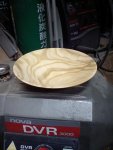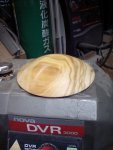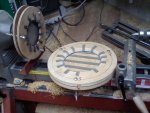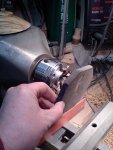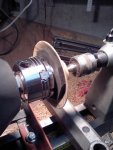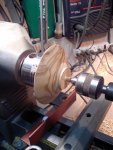Stuart Ablett
Member
- Messages
- 15,917
- Location
- Tokyo Japan
Well there seemed to be some interest in turning off the tenon on the bottom of a bowl, I was doing one tonight, so I took some pics.
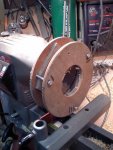
here is my smaller Donut chuck

I have a variety of rings for it, as well as an uncut blank or two.
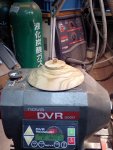
Here is a small Cherry bowl I was just about finished, I only needed to turn off the tenon on the bottom.
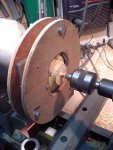
I put the bowl in the chuck, but I was not happy with the size of the hole, it was a little small, it would not allow me access to the tenon and the sanding later, so I needed to make another ring with a bit larger hole in it.
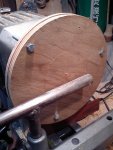
I have some blanks for just this purpose, when I made the donut chuck, I cut 4 or 5 flat rounds for it, and as I need, I make new rings. All of the blanks were drilled and indexed together, so making a new ring is easy, just line up the mark, and bolt the ring to the face of the chuck, then cut a new hole in the new blank.

Here I have cut a new hole, I left the ring with the smaller hole in place, as I did not want to damage the foam on the flat of the chuck.

I then put a round over on the inside of the ring, by hand with a sharp knife, and attach some weather stripping stuff to the ring to protect the bowl.
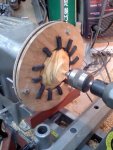
Here I've centered the bowl in the new ring, using the tail stock. You can see that this ring will allow me greater access to the bottom of the bowl

I then turn off the tenon..........

...and sand it, as well as put a coat of sanding sealer on it......
Cont............

here is my smaller Donut chuck

I have a variety of rings for it, as well as an uncut blank or two.

Here is a small Cherry bowl I was just about finished, I only needed to turn off the tenon on the bottom.

I put the bowl in the chuck, but I was not happy with the size of the hole, it was a little small, it would not allow me access to the tenon and the sanding later, so I needed to make another ring with a bit larger hole in it.

I have some blanks for just this purpose, when I made the donut chuck, I cut 4 or 5 flat rounds for it, and as I need, I make new rings. All of the blanks were drilled and indexed together, so making a new ring is easy, just line up the mark, and bolt the ring to the face of the chuck, then cut a new hole in the new blank.

Here I have cut a new hole, I left the ring with the smaller hole in place, as I did not want to damage the foam on the flat of the chuck.

I then put a round over on the inside of the ring, by hand with a sharp knife, and attach some weather stripping stuff to the ring to protect the bowl.

Here I've centered the bowl in the new ring, using the tail stock. You can see that this ring will allow me greater access to the bottom of the bowl

I then turn off the tenon..........

...and sand it, as well as put a coat of sanding sealer on it......
Cont............

